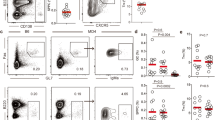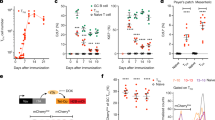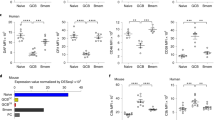Abstract
DURING an immune response, hypermutation of immunoglobulin genes in B cells proliferating within germinal centres (GCs) generates variant antibodies that react with higher affinity against either foreign or self antigens1-9. Several experiments suggest that self-reactive B cells may be censored at this stage of the immune response10-12, but the rarity of these cells and the dynamic nature of GC reactions have prevented direct analysis. We have developed a new approach to visualize the fate of antigen-specific B cells during GC reactions by seeding an ongoing immune response with lysozyme-specific B cells from immunoglobulin-gene transgenic animals. Administration of soluble antigen at the peak of the GC response rapidly eliminates lysozyme-specific GC B cells in two waves of apoptosis, one within the GC and a second in cells that have redistributed to lymphoid zones that are rich in T cells. Elimination of these cells is inhibited by constitutive expression of the follicular lymphoma proto-oncogene bcl-2. These findings reveal censoring steps that may normally prevent affinity maturation of autoantibodies to systemic autoantigens, and might be used by pathogenic microorganisms or in clinical strategies to interfere with antibody responses.
This is a preview of subscription content, access via your institution
Access options
Subscribe to this journal
Receive 51 print issues and online access
$199.00 per year
only $3.90 per issue
Buy this article
- Purchase on Springer Link
- Instant access to full article PDF
Prices may be subject to local taxes which are calculated during checkout
Similar content being viewed by others
References
Weigert, M. G., Cesari, I. M., Yonkovich, S. J. & Cohn, M. Nature 228, 1045–1047 (1970).
Tonegawa, S. Nature 302, 575–581 (1983).
Kocks, C. & Rajewsky, K. A. Rev. Immun. 7, 537–559 (1989).
Jacob, J., Kelsoe, G., Rajewsky, K. & Weiss, U. Nature 354, 389–392 (1991).
Berek, C. Berger, A. & Apel, M. Cell 67, 1121–1129 (1991).
Diamond, B. & Scharff, M. Proc. natn. Acad. Sci. U.S.A. 81, 5841–5844 (1984).
Shlomchik, M. J., Marshak-Rothstein, A., Wolfowicz, C. B., Rothstein, T. L. & Weigert, M. G. Nature 328, 805–811 (1987).
Shlomchik, M. et al. J. exp. Med. 171, 265–292 (1990).
Diamond, B. et al. A. Rev. Immun. 10, 731–757 (1992).
Linton, P.-J., Rudie, A. & Klinman, N. R. J. Immun. 146, 4099–4104 (1991).
Dintzis, H. M. & Dintzis, R. Z. Proc. natn. Acad. Sci. USA. 89, 1113–1117 (1992).
Nossal, G. J. V., Karvelas, M. & Pulendran, B. Proc. natn. Acad. Sci. U.S.A. 90, 3088–3092 (1993).
Goodnow, C. C. et al. Nature 334, 676–682 (1988).
Gammon, G. et al. Immunol. Rev. 98, 53–73 (1987).
Lavoie, T. B., Drohan, W. N. & Smith-Gill, S. J. J. Immun. 148, 503–513 (1992).
Liu, Y.-J., Zhang, J., Lane, P. J. L., Chan, E. Y.-T. & MacLennan, I. C. M. Eur. J. Immun. 21, 2951–2962 (1991).
Strasser, A. et al. Proc. natn. Acad. Sci. U.S.A. 88, 8661–8665 (1991).
Gavrieli, Y., Sherman, Y. & Ben-Sasson, S. A. J. Cell Biol. 119, 493–501 (1992).
Liu, Y.-J. et al. Nature 342, 929–931 (1989).
MacLennan, I. C. M. A. Rev. Immun. 12, 117–139 (1994).
Gray, D., Dullforce, P. & Jainandusing, S. J. exp. Med. 180, 141–155 (1994).
Pulendran, B., Kannaroukis, G., Nouri, S., Smith, K. G. C. & Nossal, G. J. V. Nature 375, 331–334 (1995).
Cyster, J., Hartley, S. & Goodnow, C. C. Nature 371, 389–395 (1994).
Radic, M. Z. & Weigert, M. A. Rev. Immun. 12, 487–520 (1994).
Kemp, D. J., Coppel, R. L. & Anders, R. F. A. Rev. Microbiol. 41, 181–208 (1987).
Padlan, E. A. et al. Proc. natn. Acad. Sci. U.S.A. 86, 5938–5942 (1989).
Prager, E. M. & Wilson, A. C. J. biol. Chem. 246, 523–530 (1971).
Cooke, M. P. et al. J. exp. Med. 179, 425–438 (1994).
Lagasse, E. & Weissman, I. L. Blood 79, 1907–1915 (1992).
Author information
Authors and Affiliations
Rights and permissions
About this article
Cite this article
Shokat, K., Goodnow, C. Antigen-induced B-cell death and elimination during germinal-centre immune responses. Nature 375, 334–338 (1995). https://doi.org/10.1038/375334a0
Received:
Accepted:
Issue Date:
DOI: https://doi.org/10.1038/375334a0
This article is cited by
-
FcγRIIb differentially regulates pre-immune and germinal center B cell tolerance in mouse and human
Nature Communications (2019)
-
B cell signaling in context
Nature Immunology (2019)
-
Poly- and autoreactivity of HIV-1 bNAbs: implications for vaccine design
Retrovirology (2018)
-
Crystal structure of duck egg lysozyme isoform II (DEL-II)
BMC Structural Biology (2018)
-
EAF2 mediates germinal centre B-cell apoptosis to suppress excessive immune responses and prevent autoimmunity
Nature Communications (2016)
Comments
By submitting a comment you agree to abide by our Terms and Community Guidelines. If you find something abusive or that does not comply with our terms or guidelines please flag it as inappropriate.



